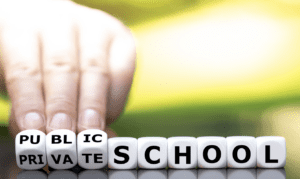
WASHINGTON, DC — When it came to funding education, the CARES Act favored private and charter schools over public schools in a big way. An analysis by Good Jobs First previously revealed that private and charter schools received about six times more per school than public schools: $855,000 per facility on average compared to $134,500 for public schools.
Charter and private schools qualified for Payroll Protection Program (PPP) loans despite already being entitled to grant funding under a separate CARES Act funding stream, the Elementary and Secondary School Emergency Relief (ESSER) Fund. Hence, many charters and privates have been “double dipping.”
Good Jobs First has been chronicling this problem at its database, Covid Stimulus Watch. Today, the national watchdog revealed a new state-by-state search feature on how much charter and private schools received.
Once you click on a state, the list can be downloaded into a spreadsheet by clicking the “csv” button. The data includes only PPP loans of $150,000 and over.
The newly enacted stimulus, dubbed CARES 2.0, provides $54 billion for K-12 public schools via ESSER—nearly four times what the CARES Act provided. But the new relief package still allows charter and private schools to double dip, accessing both ESSER funds and PPP loans. (Because public schools are neither for-profit nor non-profit corporations, they cannot access PPP loans.)
The new stimulus also allocates $2.75 billion for governors to distribute to private schools. Private schools that receive these grants are not allowed to apply for new PPP loans, but private schools that previously received a PPP loan are still eligible (and thus could be “triple-dipping”).
The Network for Public Education’s Carol Burris dug deeper into the new pandemic relief package with education historian and blogger Diane Ravitch.
These funding disparities raises serious equity issues: a lack of funding makes it more difficult to get computers and other online learning resources to students who need them the most. The funds heavily influence a school’s ability to reopen for safe, in-person learning.
“Private schools with deep endowments and steep tuition, and charters with wealthy board members shouldn’t be the big winners during a crisis disproportionately impacting low-income communities,” said Mellissa Chang, GJF’s research analyst leading this work.
Here are Good Jobs First’s analyses of how CARES Act favors private schools in Pennsylvania, where they received two and a half times more on average than public schools. In West Virginia, private schools received three times more than the average public school.
The disparities are actually worse in some states because of the ways which some corporations (such as Charter Management Organizations, or CMOs) classified themselves (using NAICS codes to identify themselves as consultants or business services rather than schools).
If you see any missing information or organizations, please contact research analyst Mellissa Chang at [email protected] or executive director Greg LeRoy at [email protected]. We will continue updating this database as new information becomes available.
Good Jobs First, based in Washington, DC, is a non-profit, non-partisan resource center promoting accountability in economic development and overall corporate accountability.